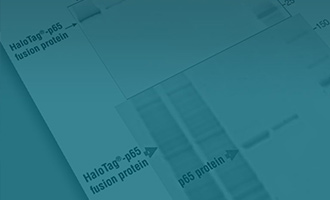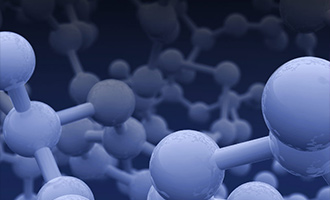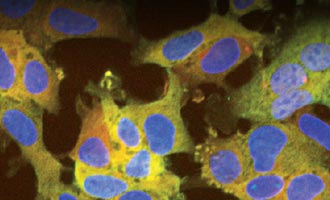HaloTag® Technology: Novel New Applications
Gary Kobs
June 2019; tpub_216
Abstract
Understanding the functional role of proteins and how they interact within the cell is increasingly important. Often multiple recombinant protein fusions are needed to accomplish this research, which at times can be slow and cumbersome because of inefficiencies from moving between different applications. As a result, there is a need for a recombinant protein tag that affords flexibility between expression and localization, protein purification, protein interaction discovery, screening and further functional analyses.
Introduction
The HaloTag® platform addresses the need for flexibility in functional protein analysis (Figure 1). This modular technology is based on the formation of a covalent bond between a fusion tag and synthetic ligands, and is designed to enable complete characterization of protein function in cellular and biochemical environments (Figure 2).
This article features recent references that illustrate the flexibility of HaloTag® technology for the following novel applications.
Combining HaloTag® + POI with HaloTag® Ligand

Figure 1. HaloTag® protein attached to protein of interest (POI), combines with chloroalkane ligand and functional group via a covalent bond.
HaloTag® Mammalian Protein Purification Protocol

Figure 2. Schematic of mammalian protein purification using HaloTag® technology.
Multiplex Autoantibody Detection
Canine mammary tumours are the most common neoplasms of female unspayed dogs. Human breast cancer studies reveal role of autoantibodies in early cancer diagnosis. In this reference the authors took advantage of a high-throughput Luminex technique for developing a multiplex assay to detect autoantibody signatures against canine mammary tumour-associated autoantigens (TAAs; 1). These TAAs were expressed separately as fusion proteins with HaloTag at the N-terminus, which allows specific covalent coupling with magnetic microspheres comprising a panel of candidate autoantigens (TPI, PGAM1, MNSOD, CMYC & MUC1).
Membrane Protein Mobility
The anesthetic isoflurane (ISO) has previously been shown to increase the fluidity of artificial lipid membranes, but very few studies have used biological cell membranes. Therefore, to investigate whether ISO affects the mobility of membrane proteins, fluorescence‐labeled transferrin receptor (HaloTag® fusion labeled with Alexa Fluor®) and glycosylphosphatidylinositol (GPI)‐anchored protein were expressed in human embryonic kidney 293T cells and neural cells. Lateral diffusion was examined using fluorescence recovery after photobleaching (2).
Mutation Effect on Kinase Activity
The phosphorylation dynamics of MEK1 in human cells was characterized by using the phosphate affinity electrophoresis technique, Phos-tag sodium dodecyl sulfate-polyacrylamide gel electrophoresis (Phos-tag SDS-PAGE). In this reference, the researchers found that multiple variants of MEK1 with different phosphorylation states are constitutively present in typical human cells (3).
The authors describe phosphorylation profiling of various MEK1 mutants with mutations identified in CFC syndrome, sporadic cancers or MEK-inhibitor-resistant cancer cells. They used Phos-tag SDS-PAGE to investigate the relationships between kinase activity or drug efficacy and the characteristics of individual mutations in the MEK1- coding gene.
A Flexi® HaloTag® clone pFN21AE0668, which is suitable for expression of N-terminal HaloTag®-fused MEK1 in mammalian cells, was prepared from Escherichia coli. Mutations were introduced into the pFN21AE0668 vector. Phos-tag SDS-PAGE was performed on each of the mutations. MEK1 kinase activity was determined by pulldown of HaloTag®-fused proteins using Magne® HaloTag® Beads (Cat.# G7281, G7282) and incubating in the presence of APT and inactive ERK1 (3).
Cell Proliferation and Differentiation
Fibroblast growth factor 18 (FGF18) is a member of the fibroblast growth factor family that is important in cartilage growth and development. However, the mechanism by which FGF18 mediates its biological functions is still unclear. In this study they expressed the rhFGF18 protein fused to a HaloTag® tag (Halo-rhFGF18; 4). MTT assay results indicated that both rhFGF18 and Halo-rhFGF18 have similar biological activities in NIH3T3 cells. Confocal imaging data indicated that the red fluorescence labeled Halo-rhFGF18 strongly bound to ATDC5 cells and stimulated their proliferation and differentiation. Halo-rhFGF18 had better biological activity on ATDC5 cells than did unfused rhFGF18. The fusion to HaloTag may have lead to higher bioactivity.
References
- Hussain, S. et al. (2018) Multiplexed autoantibody signature for serological detection of canine mammary tumours. Nature Scientific Reports 8,15785.
- Ono, J. et al. (2018). Effect of the volatile anesthetic agent isoflurane on lateral diffusion of cell membrane proteins. FEBS Open Bio. 8, 1127–34.
- Kinoshita-Kikuta, E. et al. (2019) Increase in constitutively active MEK1 species by introduction of MEK1 mutations identified in cancers. Proteins and Proteomics 1867, 62–70.
- Xu, N. et al. (2019) Expression of Halo-hFGF18 and study of its effect on differentiation of ATDC5 cells. Prot. Expr. Purif. 155, 8–14.
Flexi, HaloTag and Magne are registered trademarks of Promega Corporation. HaloLink is a trademark of Promega Corporation.
Alexa Fluor is a registered trademark of Molecular Probes, Inc.
Start on the right path to protein function investigation, with the HaloTag® technology web site.
Using HaloTag in Your Protein Analysis
Related Resources

Cleaner Protein with HaloTag® Purification Resin
Affinity-based and covalent capture of proteins are compared in this article.
Quick, Efficient Protein Purification from Mammalian Cells
In this Protein Expression and Purification paper, Ohana et al. purify functional kinases from mammalian cell culture.